Shoreline Management of trees is a complex issue, it involves a through knowledge of, Soils, Hydrology,Geology, Tree Biology, Tides/Ocean-currents and Complex Gravitational forces. The following is a brief overview of just some of the impacts we have to Assess as we look to manage our shorelines and comply with the federally mandated “Shoreline Management Act” that affects all of our shorelines, even those of the interior Pacific Northwest. Contact us with your shoreline management needs, and see how we can assist you with a custom management plan for your site.
Trees, Soils, Geology, and Slope Stability
The following drawings and narratives are provided as a very simplified representation of how trees may influence slope stability on Puget Sound marine shorelines. They illustrate several generalized combinations of soil depth, stratigraphy, and tree rooting. The degree to which trees may influence stability on a given slope is a complex function of various specific, interacting physical, biotic, and human-related factors.
Physical factors include slope geometry and gradient, geologic materials, stratigraphy, hydrology, and the local effects of shore processes. Climatic variability can alter the dynamic equilibrium of a slope in significant ways.
The species mix of trees as well as their spacing, age, vigor and health, influence how effectively trees can stabilize slopes. The successional stage and complexity of the associated plant community can be a significant factor. The role of associated vegetation, though significant, in effecting hydrologic conditions, soil formation, and other factors which may influence erosion rates and slope stability is not addressed here.
Forested marine slopes are often barely stable, have adjusted to the various forces acting on them and have developed a delicate equilibrium. They are sensitive to alterations such as view clearing and tree removal, as well as upland site development such as lot clearing and grading. They may also be highly sensitive to cumulative up-slope disturbance and local watershed modifications which effect slope hydrology. Disturbances such as logging, road-building, and urbanization in developing watersheds can significantly alter conditions and upset the dynamic equilibrium of slopes, thereby indirectly causing increased landslide activity on previously stable slopes.
It should be emphasized that the following examples are greatly simplified when compared to actual conditions found on Puget Sound shorelines. For example; our shorelines are often steeper and the subsoil’s (geologic parent materials) are complex, resulting in erratic concentrations of groundwater, which complicate slope stability assessments.
Type A
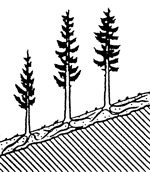
Characterized by shallow (less than 3 feet) soils overlaying parent material (competent rock, glacial till, dense silt or clay) which resists root penetration. Surface soils are fully reinforced with tree roots. Lateral rooting, though shallow, often resists slope failures if tree density and distribution is adequate to provide an interconnected root-web matrix. Rooting is plate-like. Roots are at failure plane. Subject to rapid, shallow slides during extreme rain-on-snow events.
Stabilizing effect of roots: Moderate if not compromised. Tends to become rapidly unstable when disturbed, or subjected to increased hydrological influences. Anchoring – minor. Soil cohesion – high.
Type B
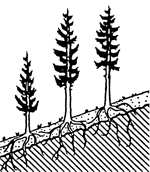
Characterized by shallow (less than 3 feet) soils overlaying parent material (dense sand, glacial till, etc.) which allows significant root penetration. Degree of anchoring into parent material by roots is dependent on the nature of the fractures in the parent material and the predominant tree species. Roots intersect potential failure plane, providing shear resistance.
Stabilizing effect of roots: High. Individual trees are stable without a significant dependence on adjacent trees. Both anchoring and soil cohesion benefits are high.
Type C
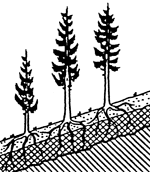
Characterized by deeper soils (3-12 feet) with a non-distinct transition zone in which soil shear strength increases with depth. Assumptions include: (1) transition zone functions as a drainage moderator, allowing a concentration of groundwater and increased pore-water pressure; (2) failure plane passes through the transition zone; (3) soil zone is more easily penetrated and permeated by roots than in B, above. (Example: sandy loam over loose till over compacted till.)
Stabilizing effect of roots: Anchoring – high. Soil Cohesion – high.
Type D
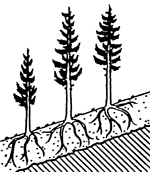
Characterized by deep soils where both the failure plane and the soils are deeper than the root zone. The actual depth of the soil for this condition to occur depends on root morphology (depth, spread, etc.) of the particular tree species on the slope. For example, on a slope where Red alder predominates, a relatively shallower soil depth would exhibit Type D conditions, while on a slope forested by Douglas-fir the stabilizing effects would be significantly greater for the same depth.
Stabilizing effect of roots: Anchoring – minor. Soil Cohesion – moderate.



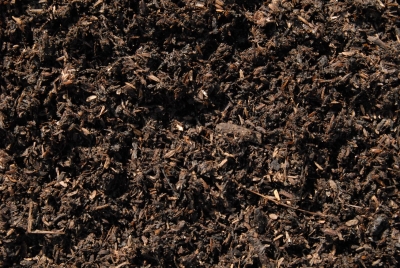





Recent Comments